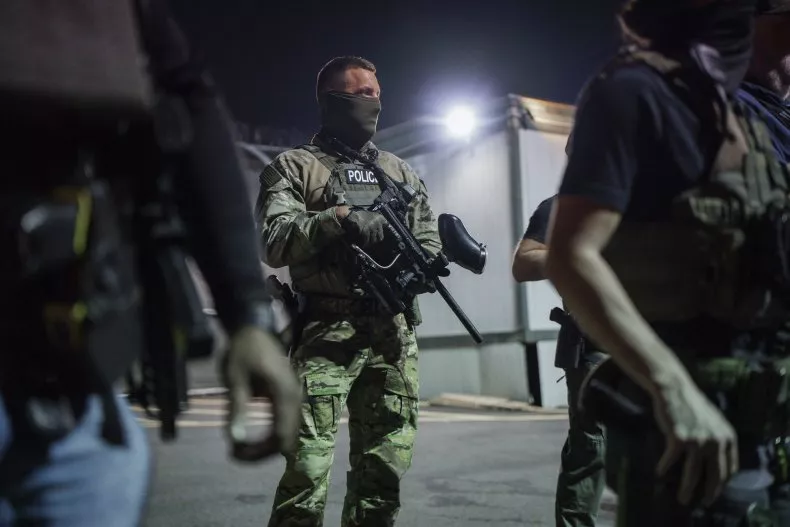ICE Agents Forced to Wear Visible ID Under New VISIBLE Act kicks off a major shift in federal immigration enforcement: lawmakers are pushing for accountability by mandating clearly displayed identification during public operations. The bipartisan legislation, known colloquially as the VISIBLE Act, aims to ban non‑medical face coverings—except under specific safety or tactical exceptions—ushering in heightened transparency and public trust amid growing civil rights concerns.
Accountability in Immigration Enforcement
In response to mounting criticism surrounding ICE’s use of masks, balaclavas, and unmarked vehicles during enforcement operations, Democratic Senators Alex Padilla (CA) and Cory Booker (NJ) introduced the VISIBLE Act on July 8, 2025. Under this proposed law:
- ICE and CBP agents must prominently display legible identification—name or badge number—along with their agency affiliation.
- Non‑medical face coverings are prohibited unless for environmental protection or covert missions.
These measures directly respond to high-profile incidents: heavily armed, masked agents detaining individuals without apparent ID sparked public outcry and were likened to “kidnappings.”
Rising Demand for Transparency and Safety
Critics spanning the political spectrum have decried the anonymity of masked ICE agents. Nancy Gibbs of The Washington Post warned that face concealment “shreds rights and alienates the public,” undermining accountability and public safety. Similarly, Axios reported that the bill’s goal is to “increase transparency and accountability” after images of unidentifiable agents caused widespread alarm.
Supporters argue that visible ID standards are not just symbolic—uniform police forces must display credentials to prevent impersonation and present fundamental trust. In contrast, opponents, including DHS officials, emphasize the personal risk to agents:
“People are out there taking photos… posting them online with death threats,” said DHS spokesperson Tricia McLaughlin theguardian.com.
Federal vs. Local Efforts
The VISIBLE Act follows mounting pressure at the local level. In Chicago, seven Illinois state representatives co-sponsored the “No Secret Police Act,” which similarly prohibits face coverings and mandates visible credentials. California lawmakers are pursuing parallel state laws. While federal preemption laws make local regulation legally complex, these statutes underscore growing grassroots demand for enforcement reform.
Legislative Hurdles and Political Context
Despite bipartisan concern, the VISIBLE Act faces an uphill journey. Axios notes it is a “long-shot” proposal without clear Republican support. The House version—the No Masks for ICE Act—lacks GOP co‑sponsors and is unlikely to advance in a Republican-controlled chamber.
Meanwhile, ICE Director Todd Lyons has defended mask usage, citing a “413 % increase in assaults” on agents, including potential doxxing of their families.
Legal Framework for ICE Identification
Examining current law, The Washington Post outlined ICE’s authority and limitations: agents must identify themselves “as ‘immigration officers’ as soon as practicable,” yet face no legal requirement to display personal names or badge numbers, especially if they believe their safety is at risk washingtonpost.com. Masks remain legally permissible, though controversial, highlighting a gap the VISIBLE Act aims to close.
Community Response: Fear and Impersonation Risk
Masked enforcement operations have fostered fear and confusion within immigrant communities. In Los Angeles, videos of raids with drums and smoke grenades stoked panic, while incidents of impersonators posing as ICE agents have surged—one man in Houston faked an immigration stop to rob and assault a driver. Advocates say visible ID would reduce dangerous impersonations and enable bystanders to distinguish legitimate authority from fraud.
Balancing Rights and Officer Safety
Supporters of the VISIBLE Act argue that badge visibility fosters public trust without impeding law enforcement. Former DHS official Scott Shuchart praised the bill as “commonsense” and simple to implement.
DHS counters that masks protect officers from targeted violence, referencing a 690 % year‑over‑year surge in assaults, from 10 to 79 between January–June 2024 compared to 2025. The legislation, therefore, includes safety carve‑outs—allowing masks in hazardous environments or undercover operations.
Next Steps and Prospects for Passage
The VISIBLE Act is set for committee review in the Senate. Its ultimate success will hinge on:
- Republican support in at least one chamber
- Bipartisan consensus on the importance of visible ID over anonymity
- Convincing DHS that transparency can coexist with officer safety
Even if stalled in Congress, continued grassroots advocacy may pressure DHS to issue internal regulations requiring badge display and limiting face coverings voluntarily.
Conclusion
The VISIBLE Act marks a pivotal moment in reimagining federal immigration enforcement, favoring transparency, accountability, and community safety. In an era where authorities increasingly operate with anonymity, the public demand for visible identification and limited concealment reflects a broader demand: law enforcement must be recognizable, responsible, and answerable.
Subscribe to trusted news sites like USnewsSphere.com for continuous updates.





